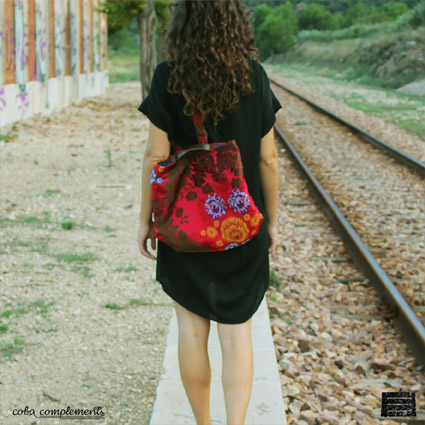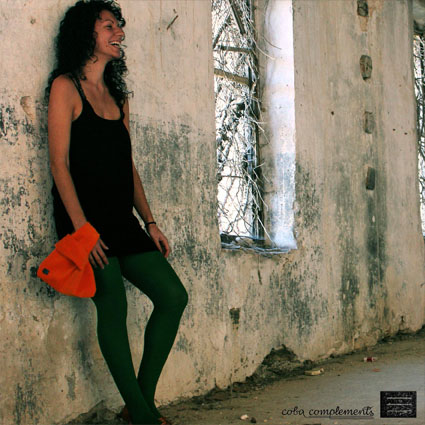Andrea Coderch Valor
In the Alchimia didactic framework exchange experiences play a central role, complete the education and can give the final touch before entering professional life.
Andrea went for 3 months to Japan as exchange student at the Hiko Mizuno College of Jewelry. Japan had been already very present in her work, as the Alchimia graduation work shows clearly.

Andrea Coderch Valor
Alchimissima: After BA in industrial design at the Politecnico di Valencia and three years of jewellery in Alchimia you went for an exchange to Japan. It seems that this experience was very important for you.
Could you tell us a bit about it ?
Andrea: My idea before going there was very ‘cold’. What I mean is that I thought it would be very difficult to make close friends and to really enter into Tokyo and its atmosphere, but then things went very differently. Chihiro Fujita the girlfriend of a classmate in school changed everything for me. First I was shocked,I was the first foreign person she had ever met, she did not speak any english, but in one month she learned the basics to be able to communicate with me.
It was amazing to see her dedication in everything she did. Experiencing this changed something in my mind. I think the most important thing in life is to be continuous and persistent.
She taught me that you need to follow your dream even though it does not work at the beginning.
You have to really believe in what you do and you have to completely invest in yourself.
Alchimissima: Do think this is a Japanese way of thinking or was it just her ?
Andrea: I do not know, but I think the Japanese really fight for what they want. They all want to succeed in what they are doing and they work extremely hard. In Japan I saw that people focus on one thing until they can do it perfectly and they will not stop and do something else before they have reached perfection.

Andrea Coderch Valor, brooch, Shibuichi, textile
Alchimissima: So this lesson was for the most important for you ?
Andrea: I think so, I learned a lot of things, but this one really changed me and my perception of life. Before this experience in Japan, I would do things being mostly concerned in what others would like or not. It was like cutting my own wings instead of flying free. Japan gave me a “click”, which was or better is before all I have to LOVE what I am doing without compromise.
Alchimissima: You have founded your own company now that you are in Spain, did you take this decision already in Japan
Andrea: In a way yes, in this time in Tokyo, I saw many things, styles, ways of dressing…It was like searching on internet about fashion but “in live” it was real. My mind was working and making plans for the future. I thought it could be exciting to start my own company, to be brave even though the economy in my country is very much in crises right now.

Alchimissima: Did you take the decision to work with accessories and not only jewellery in Japan ?
Andrea: I had done a course in bag design years ago, but then in Hiko Mizuno I was near to shoe and bag designers who were really making their pieces and not just designing on the computer. So I also learned from them the techniques that I am using now.

Alchimissima: So you think when one studies design one should also learn the craft!!
Andrea: OF COURSE! I think this is really important, because when I studied industrial design I designed a lot of things on the computer but did never really know if they would actually work out in reality. That’s why when I started with jewellery I was so happy because I could do the things I had in my mind with my hands.
Alchimissima: What happens actually when you work with your hands ?
Andrea: While you work with your hands you feel what you are doing and the act working makes your brain work constantly with you but at the same time the brain is free to make new associations which then help to continue modify and develop the work you are doing, and more and more ideas and possibilities can come.
It is as if the hands might know more than your brain yet does…………so in this sense I think it is really important to learn to make.

Alchimissima: What did it feel like to be back in Spain after three months of Tokyo?
Andrea: At first it was a real cultural shock again. Before going to Tokyo I had been obsessed with Japan and I had wanted to live there. After three months I was happy to go home and I know now that I could not live in Japan. Visit yes, but short periods, if you tell me I could have a job in Japan, I probably would not accept it.
I also appreciated much more the way I am living in my hometown after the experience of Japan.
So I knew I wanted to stay where I am and find a possibility to work here, which is not easy because of the crisis. It had to think a lot and it is really hard to be autonomous and you really have to think because you can also lose a lot of money. I am lucky that my parents support and help me.

Alchimissima: Do you think you would have started your own company without the support of your family?
Andrea: Yes, but it would have taken much more time, instead of some months, it might have taken years. An important point is that I can get a totally honest critique and suggestions from my parents which is not that easy alone or with others. The family is the tester and so I feel more free in the sense that I know they will give me critique in a positive sense.
I would love to find a team-mate, but I did not find it for now, but I believe it will happen. It is better to work in a team, more brains to think and hands to work and shared success is also better.

Alchimissima: You started your collections with just 3 basic designs which makes your products very simple but does not give a huge variety of choice. Is this a decision just for the beginning or is this part of the concept of your brand ?
Andrea: For now it will more or less remain like this because I focus mostly on the material. There are only basic forms but the choice of materials and colours is vast. I also wanted to take profit of the textile production in my area, which is very much in crisis in this period. In this way I get the feeling that I am contributing (a bit) to the development of the area and I can be a small example for other young people not to give up.

Alchimissima: I saw that you are starting a collaboration with a crowd funding platform. What do you think about this?
Andrea: I started with a type of crowd funding where you sell your products, because I want to see if people actually like what I am doing and also the platform is very new and I like to collaborate with people that are starting like me. We have to support each other.
This platform is called Fromlab, here is the link if someone is interested in collaborate www.fromlab.com
Another important event for Coba Complements is we are going to the Eunique fair in Germany, I am very happy they accepted our proposal.
It is next May, and I am very excited to see what kind of response I will get in a fair.
Thank you very much Andrea and we all wish you lots of success.
For all those interested the links to Andrea’s company:
Coba Complements: www.cobacomplements.com
















